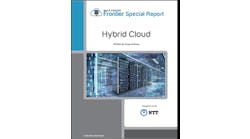According to a recent State of the Edge report, the global capital expenditure on IT equipment for edge infrastructure is projected to grow to $104 billion by 2028. Moreover, recent IDC research forecasts worldwide spending on edge computing platforms to reach nearly $274 billion by 2025.
As AFL executives in a related DCF 'Voices of the Industry' essay from earlier this year explained further, "Edge data centers are key to unleashing advanced use cases resulting in new user experiences and new business opportunities."
As recently as last month, a market brief from JLL unpacked just why smaller data centers are taking off, as AI, 5G and hybrid work fuel an exponential expansion of edge computing footprints.
As noted by the brief, "Hyperscale centers are usually located in cities and can typically house 10,000 racks with a capacity in excess of 80 MW. Edge data centers by comparison, have a smaller capacity between 500 kilowatts to 2 MW and, as the name suggests, are located on the outer edge of networks. They bring computing capability geographically closer to those users situated further away from the heart of the cloud."
“These assets are increasingly important to the architecture of computing networks, thanks to the continued adoption of IoT devices and now the rise of generative AI applications, and machine learning,” added Tom Glover, JLL Head of EMEA Data Center Transactions.
For its part, PricewaterhouseCoopers International Limited (PwC) recently noted that "the global market for edge data centers is expected to nearly triple to $13.5 billion in 2024 from $4 billion in 2017, thanks to the potential for these smaller, locally located data centers to reduce latency, overcome intermittent connections and store and compute data close to the end user."
PwC's edge data center examination cautioned, "However, the right timing and strategy for moving data centers (and related services) to the edge will be different for each organization, depending on the conditions, environment and business opportunities in its marketplace."
So even just a cursory reading of the business and technology prospects for edge data centers told DCF's editors that it was time for a podcast discussion probing the history and reach of this most evergreen (yet paradoxically sometimes elusive) technology topic for our industry.
Listen to today's show:
Here's a summary points discussed by DCF editors Matt Vincent and David Chernicoff in today's podcast.
1:01 - Framing the topic with a Bill Kleyman quote.
2:06 - Comparing and contrasting the "original" or "local" edge vs. the hyperscale version.
3:33 - How a lot of edge data centers have come out of the CDN model.
4:23 - From Google and AWS to Akamai, Cloudflare and Rackspace.
6:46 - Optimizing delivery at the edge to challenge the hyperscalers for business.
7:45 - Blending edge computing and edge data centers to move data around as little as possible.
9:11 - 5G and telco: The 'red-headed stepchild' of the edge data center?
9:43 - "If you think about it, every cell tower you see has a data center attached to it."
11:32 - Many major CSPs didn't expect the kind of usage their cell towers are getting.
12:35 - On self-driving cars and autonomous vehicles as competitive edge use-cases.
14:26 - Leveraging 5G, actual connectivity, and localized data centers.
15:17 - How latency and bandwidth have become huge issues in gaining a business advantage.
15:34 - Edge permutations redux.
16:47 - "You just had to work AI into the conversation, didn't you?"
17:50 - When data center-quality analytics live in the trunk of a vehicle.
18:25 - Qualcomm: "Wherever a phone is, that's the edge."
19:21 - "Think of the issues involved. The backhaul, the latency, the security of that data moving across that much fiber."
20:15 - Latency Makes People Go Away
21:31 - "There's certainly a lot more edge-type data centers being built than giant hyperscaler data centers."
22:03 - What have supply chain issues done to these smaller data center builds?
22:40 - How edge data center development may depend on what the market does.
23:12 - Engineering the industrial vs. the suburban edge in rural areas.
26:10 - Closing thoughts: "What's old is new again...The first point of contact is the edge."
Here are links to some recent DCF stories on edge data centers:
- Akamai Bets on Bringing Cloud In Closer with 5 New Data Center Sites
- Getting Closer to the Edge: Data Centers Move Closer to Consumption
- Roundtable: Growth Seen Across Many Flavors of Edge Computing
- Data Center Insights: Phillip Marangella of EdgeConneX
- Tower Operators Step Up the Pace of Their Edge Deployments
- Let Form Follow Function at the Edge
Did you like this episode? Be sure to subscribe to the Data Center Frontier show at Podbean to receive future episodes on your app.

Matt Vincent
A B2B technology journalist and editor with more than two decades of experience, Matt Vincent is Editor in Chief of Data Center Frontier.





